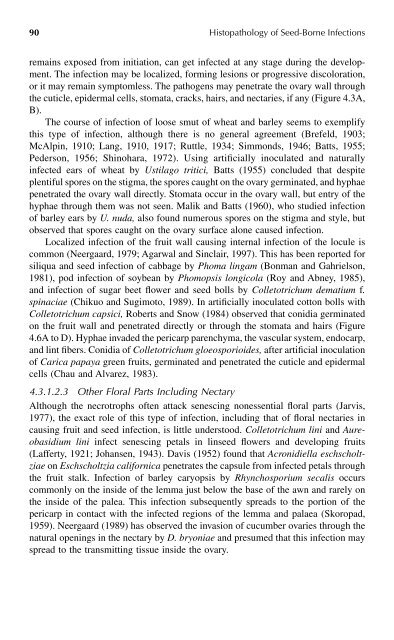Histopathology of Seed-Borne Infections - Applied Research Center ...
Histopathology of Seed-Borne Infections - Applied Research Center ...
Histopathology of Seed-Borne Infections - Applied Research Center ...
You also want an ePaper? Increase the reach of your titles
YUMPU automatically turns print PDFs into web optimized ePapers that Google loves.
90 <strong>Histopathology</strong> <strong>of</strong> <strong>Seed</strong>-<strong>Borne</strong> <strong>Infections</strong>remains exposed from initiation, can get infected at any stage during the development.The infection may be localized, forming lesions or progressive discoloration,or it may remain symptomless. The pathogens may penetrate the ovary wall throughthe cuticle, epidermal cells, stomata, cracks, hairs, and nectaries, if any (Figure 4.3A,B).The course <strong>of</strong> infection <strong>of</strong> loose smut <strong>of</strong> wheat and barley seems to exemplifythis type <strong>of</strong> infection, although there is no general agreement (Brefeld, 1903;McAlpin, 1910; Lang, 1910, 1917; Ruttle, 1934; Simmonds, 1946; Batts, 1955;Pederson, 1956; Shinohara, 1972). Using artificially inoculated and naturallyinfected ears <strong>of</strong> wheat by Ustilago tritici, Batts (1955) concluded that despiteplentiful spores on the stigma, the spores caught on the ovary germinated, and hyphaepenetrated the ovary wall directly. Stomata occur in the ovary wall, but entry <strong>of</strong> thehyphae through them was not seen. Malik and Batts (1960), who studied infection<strong>of</strong> barley ears by U. nuda, also found numerous spores on the stigma and style, butobserved that spores caught on the ovary surface alone caused infection.Localized infection <strong>of</strong> the fruit wall causing internal infection <strong>of</strong> the locule iscommon (Neergaard, 1979; Agarwal and Sinclair, 1997). This has been reported forsiliqua and seed infection <strong>of</strong> cabbage by Phoma lingam (Bonman and Gahrielson,1981), pod infection <strong>of</strong> soybean by Phomopsis longicola (Roy and Abney, 1985),and infection <strong>of</strong> sugar beet flower and seed bolls by Colletotrichum dematium f.spinaciae (Chikuo and Sugimoto, 1989). In artificially inoculated cotton bolls withColletotrichum capsici, Roberts and Snow (1984) observed that conidia germinatedon the fruit wall and penetrated directly or through the stomata and hairs (Figure4.6A to D). Hyphae invaded the pericarp parenchyma, the vascular system, endocarp,and lint fibers. Conidia <strong>of</strong> Colletotrichum gloeosporioides, after artificial inoculation<strong>of</strong> Carica papaya green fruits, germinated and penetrated the cuticle and epidermalcells (Chau and Alvarez, 1983).4.3.1.2.3 Other Floral Parts Including NectaryAlthough the necrotrophs <strong>of</strong>ten attack senescing nonessential floral parts (Jarvis,1977), the exact role <strong>of</strong> this type <strong>of</strong> infection, including that <strong>of</strong> floral nectaries incausing fruit and seed infection, is little understood. Colletotrichum lini and Aureobasidiumlini infect senescing petals in linseed flowers and developing fruits(Lafferty, 1921; Johansen, 1943). Davis (1952) found that Acronidiella eschscholtziaeon Eschscholtzia californica penetrates the capsule from infected petals throughthe fruit stalk. Infection <strong>of</strong> barley caryopsis by Rhynchosporium secalis occurscommonly on the inside <strong>of</strong> the lemma just below the base <strong>of</strong> the awn and rarely onthe inside <strong>of</strong> the palea. This infection subsequently spreads to the portion <strong>of</strong> thepericarp in contact with the infected regions <strong>of</strong> the lemma and palaea (Skoropad,1959). Neergaard (1989) has observed the invasion <strong>of</strong> cucumber ovaries through thenatural openings in the nectary by D. bryoniae and presumed that this infection mayspread to the transmitting tissue inside the ovary.


